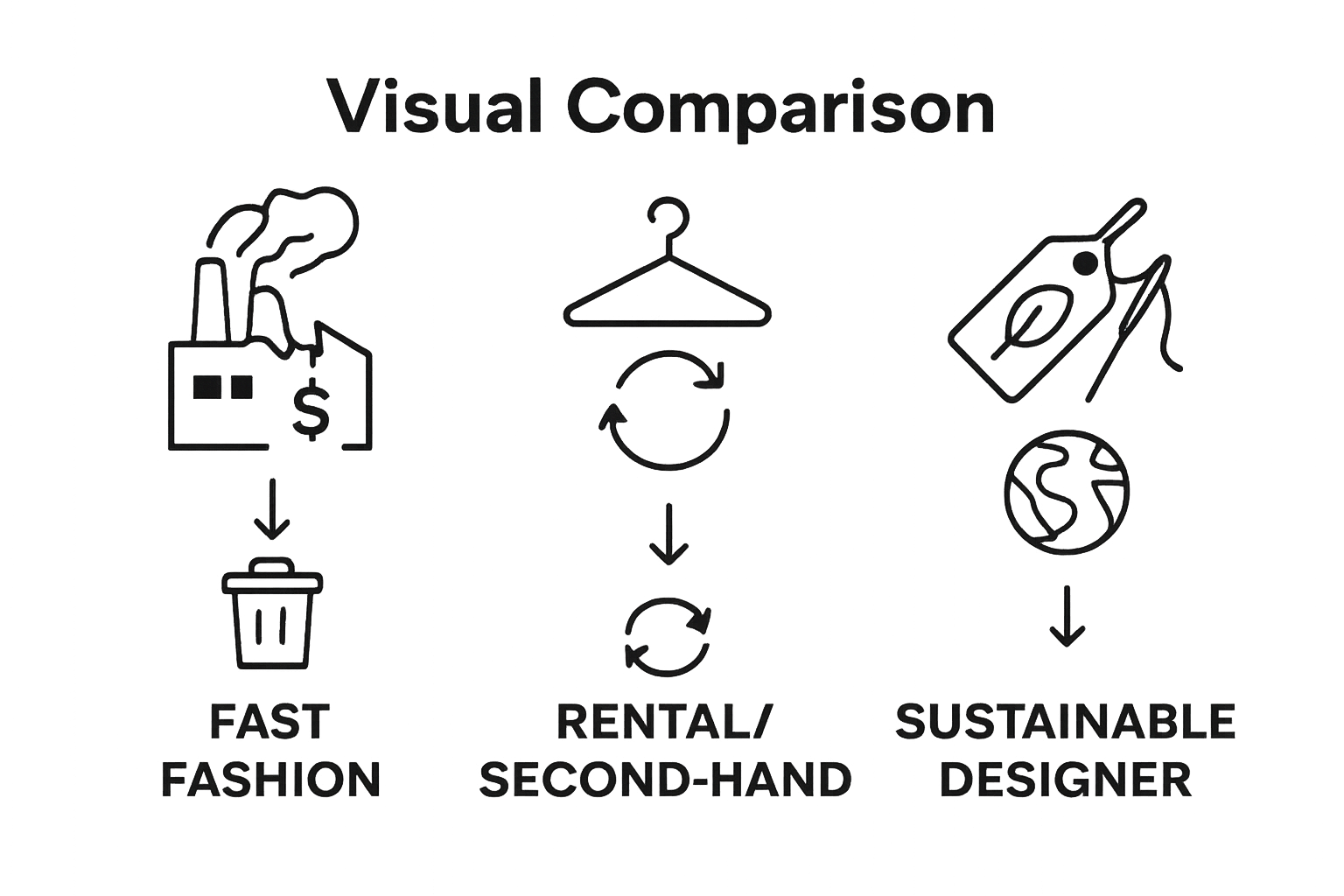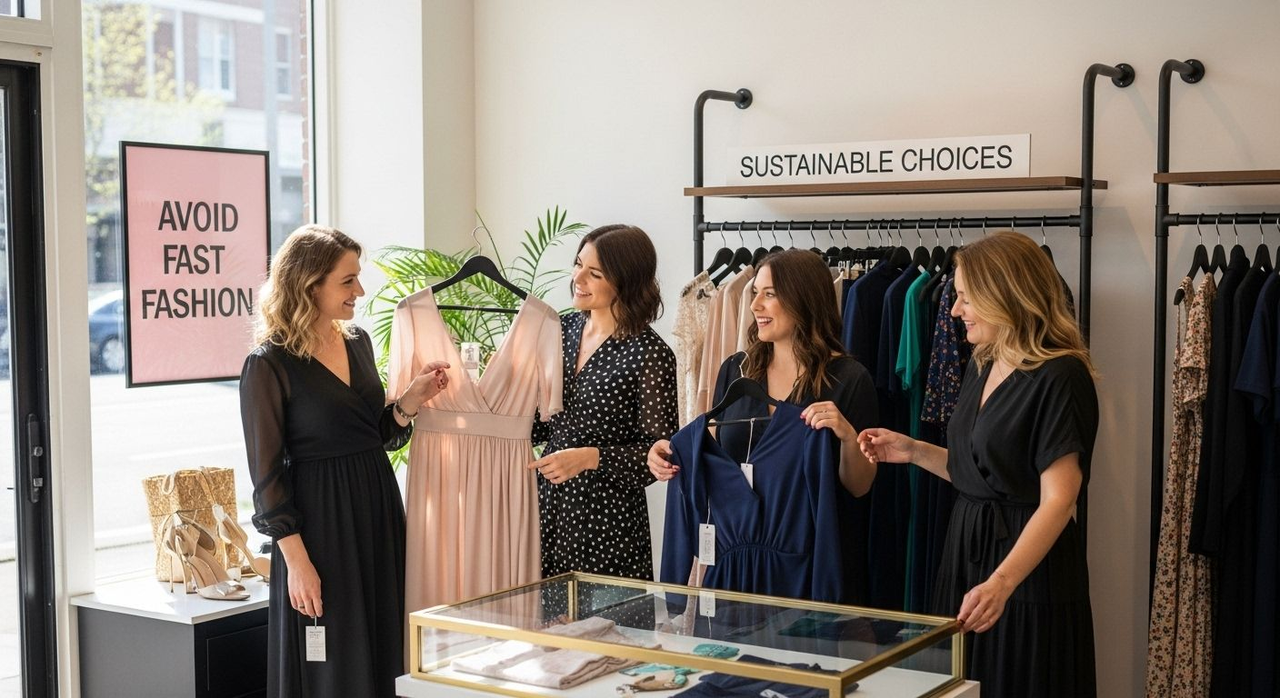Understanding How to Avoid Fast Fashion for Special Events
Understanding How to Avoid Fast Fashion for Special Events

Fast fashion has completely changed the way people shop for clothes and pushed trends into stores at lightning speed. Some brands now release up to 100 new styles every single week, far beyond the old pace of four annual collections. That sounds exciting if you love options. But beneath the never-ending flood of cheap fashion lies a massive web of pollution, labor abuse, and waste that most shoppers never consider.
Table of Contents
- What Is Fast Fashion And Why It Matters
- The Environmental Impact Of Fast Fashion On Our Planet
- The Social Implications Of Fast Fashion In The Fashion Industry
- How To Make Mindful Choices For Special Occasion Outfits
- Alternatives To Fast Fashion: Sustainable And Ethical Options
Quick Summary
| Takeaway | Explanation |
|---|---|
| Fast fashion accelerates clothing waste. | Approximately 85% of textiles are discarded annually, creating significant landfill challenges. |
| Production contributes to carbon emissions. | The textile industry generates more greenhouse gases than international shipping and aviation combined. |
| Seek brands with ethical practices. | Research brands for sustainability, transparent labor practices, and responsible production methods before purchasing. |
| Choose versatile, quality pieces. | Invest in outfits that can be reworn or repurposed to reduce waste and maximize value. |
| Explore alternative fashion options. | Consider renting, buying second-hand, or supporting local artisans for sustainable choices. |
What is Fast Fashion and Why It Matters
Fast fashion represents a modern clothing production model characterized by rapidly producing trendy, low-cost garments that quickly replicate designer styles and runway looks. This phenomenon has dramatically transformed the global fashion industry over the past two decades, creating a complex ecosystem of mass manufacturing, accelerated consumption, and significant environmental consequences.
Understanding the Fast Fashion Mechanism
The fast fashion business model operates on an unprecedented speed of production and consumption. Clothing manufacturers leverage extremely agile supply chains to design, produce, and distribute new clothing collections within weeks, sometimes even days. Traditional fashion cycles used to involve seasonal collections with 4 primary releases per year. In contrast, fast fashion brands now introduce 50-100 new styles weekly, encouraging constant consumer purchasing and creating an illusion of perpetual trend obsolescence.
Environmental and Social Impact
According to the United Nations Environment Programme, fast fashion generates substantial environmental challenges:
- Textile production generates more carbon emissions than international flights and maritime shipping combined
- The industry consumes massive water resources, with a single cotton shirt requiring approximately 2,700 liters of water
- Clothing waste has increased dramatically, with most discarded garments ending up in landfills or developing countries
Beyond environmental concerns, fast fashion frequently relies on exploitative labor practices in developing countries, where workers endure low wages, unsafe working conditions, and minimal labor protections. The pursuit of extremely low production costs creates a systemic cycle of human and environmental exploitation that undermines sustainable economic development.
By understanding fast fashion’s intricate mechanisms, consumers can make more informed choices about their clothing purchases, prioritizing quality, sustainability, and ethical production over temporary trends and disposable fashion.
The Environmental Impact of Fast Fashion on Our Planet
The environmental consequences of fast fashion extend far beyond clothing production, representing a global ecological crisis that threatens planetary sustainability. This industry generates unprecedented levels of pollution, resource depletion, and waste, creating a complex web of environmental challenges that demand immediate attention and transformative action.
Carbon Emissions and Climate Change
Fast fashion significantly contributes to global carbon emissions, with textile production generating more greenhouse gases than international maritime shipping and aviation combined. Clothing manufacturing processes involve energy-intensive activities like cotton cultivation, fabric production, dyeing, and transportation, each stage adding substantial carbon footprints. Research from Massachusetts Institute of Technology indicates that the fashion industry accounts for approximately 7% of global exports and experiences exponentially unsustainable growth.
Water Consumption and Pollution
The textile industry is an enormous water consumer, with staggering environmental consequences. A single cotton shirt requires approximately 2,700 liters of water, while industrial dyeing processes release toxic chemicals directly into water systems. Key environmental challenges include:
- Massive freshwater consumption in cotton farming
- Chemical contamination of rivers and groundwater
- Destruction of aquatic ecosystems through textile manufacturing
- Microplastic pollution from synthetic fabric production
Waste Generation and Landfill Crisis
Fast fashion’s disposable nature creates unprecedented waste challenges. Most garments are designed for short-term use, with an estimated 85% of textiles ending up in landfills annually. These discarded clothing items can take hundreds of years to decompose, releasing methane and other harmful greenhouse gases. The global waste generated by this industry represents a critical environmental problem, with developing countries often bearing the burden of receiving and processing discarded clothing from wealthier nations.
Understanding these environmental impacts empowers consumers to make more conscious clothing choices, supporting sustainable fashion practices that prioritize ecological preservation and responsible consumption.
Below is a table summarizing the key environmental impacts of fast fashion for easier comparison and understanding.
| Environmental Impact | Description |
|---|---|
| Carbon Emissions | Textile production emits more greenhouse gases than international shipping and aviation combined. |
| Water Consumption | Cotton farming and manufacturing require massive water use (2,700 liters for one shirt). |
| Water Pollution | Industrial dyeing releases toxic chemicals; microplastics from synthetics pollute water systems. |
| Waste Generation | About 85% of textiles are discarded annually, mostly ending up in landfills. |
| Landfill & Methane Emissions | Discarded garments take centuries to decompose, releasing methane and greenhouse gases. |
| Impact on Developing Countries | Many discarded garments are shipped to developing countries, burdening their waste systems. |
The Social Implications of Fast Fashion in the Fashion Industry
Fast fashion represents more than an environmental challenge. It is a complex social ecosystem that deeply impacts human lives, labor dynamics, and economic structures across global communities. The industry’s rapid production model creates profound social consequences that extend far beyond clothing manufacturing.
Labor Exploitation and Working Conditions
Global supply chains in fast fashion systematically perpetuate labor exploitation, particularly in developing countries. Workers, predominantly women, endure hazardous working environments, extremely low wages, and minimal labor protections. According to Sustainability Research, these practices fundamentally undermine basic human rights and create cyclical economic vulnerability for entire communities. Garment workers frequently experience:
- 12-16 hour mandatory work shifts
- Wages significantly below living standards
- Dangerous workplace infrastructures
- Limited collective bargaining rights
- Restricted personal freedom and mobility
Economic Disruption and Cultural Impact
Fast fashion’s global expansion fundamentally transforms local economies and traditional textile industries. Mass-produced, low-cost clothing undermines local artisan economies, displacing centuries-old craftsmanship and cultural textile traditions. Small-scale manufacturers and traditional textile workers struggle to compete with large-scale, technologically advanced production systems that prioritize speed and cost-efficiency over quality and cultural preservation.
Gender Dynamics and Workforce Inequality
The fast fashion industry disproportionately affects women, who represent approximately 80% of garment workers worldwide. Despite constituting the majority of the workforce, women consistently experience lower wages, more precarious working conditions, and limited opportunities for professional advancement. The industry’s structure perpetuates gender-based economic inequalities, trapping women in cyclical poverty and limiting their socioeconomic mobility.
Recognizing these social implications empowers consumers to make more ethical clothing choices, supporting industries that prioritize human dignity, worker rights, and sustainable economic development.
How to Make Mindful Choices for Special Occasion Outfits
Choosing ethical and sustainable clothing for special events requires thoughtful consideration and a strategic approach. By understanding the deeper implications of fashion consumption, individuals can transform their wardrobe choices into meaningful statements of personal values and environmental responsibility.
Research and Brand Assessment
Before purchasing a special occasion outfit, comprehensive brand research becomes critical. According to International Journal of Environmental Research and Public Health, consumers should evaluate clothing brands based on their sustainability practices, labor standards, and environmental commitments. Key aspects to investigate include:
- Transparency in manufacturing processes
- Use of sustainable materials
- Fair wage and working condition policies
- Carbon footprint and waste reduction strategies
- Certifications from recognized ethical fashion organizations
Sustainable Purchasing Strategies
Mindful outfit selection involves prioritizing quality, versatility, and longevity over temporary trends. Investment pieces that can be reworn, altered, or repurposed represent a more responsible approach to special occasion fashion. This strategy not only reduces waste but also provides better value for consumers. For those seeking designer options that align with ethical standards, explore our curated designer collection that combines style with sustainable principles.
Alternative Outfit Sourcing
Expanding beyond traditional retail, mindful consumers can explore multiple outfit acquisition methods that minimize environmental impact. These alternative approaches include:
- Renting designer dresses for one-time events
- Purchasing second-hand or vintage clothing
- Attending clothing swap events
- Collaborating with local tailors for custom, sustainable pieces
- Utilizing online platforms specializing in ethical fashion rentals
By adopting a holistic perspective on clothing consumption, individuals can make powerful choices that respect both personal style and global environmental sustainability.

Alternatives to Fast Fashion: Sustainable and Ethical Options
Addressing the complex challenges of fast fashion requires exploring comprehensive alternatives that prioritize environmental sustainability, ethical production, and thoughtful consumption. These alternatives represent transformative approaches to clothing acquisition that challenge traditional retail paradigms and empower consumers to make more responsible choices.
Sustainable Clothing Brands and Designers
Ethical fashion brands have emerged as powerful alternatives to traditional fast fashion models. These organizations prioritize transparency, environmental responsibility, and worker welfare throughout their production processes. Key characteristics of sustainable clothing brands include:
- Use of recycled or organic materials
- Fair labor practices and living wages
- Transparent supply chain documentation
- Minimal environmental impact manufacturing
- Commitment to circular fashion principles
Circular Fashion and Clothing Lifecycle Management
Circular fashion represents a revolutionary approach to clothing consumption that extends beyond traditional linear production models. This system emphasizes clothing longevity, recyclability, and minimal waste. Consumers can participate in circular fashion through strategies like clothing repair, upcycling, and participating in textile recycling programs. For those interested in exploring designer options that align with these principles, discover our sustainable dress collection that embodies circular fashion concepts.
Community-Driven Fashion Alternatives
Community-based fashion alternatives provide innovative solutions to traditional consumption patterns. These approaches transform clothing acquisition from a purely transactional experience into a collective, sustainable practice. Emerging models include:
- Clothing swap networks
- Community repair workshops
- Peer-to-peer clothing rental platforms
- Local artisan and small-batch clothing production
- Digital platforms connecting sustainable designers with consumers
By understanding and supporting these alternatives, consumers can actively contribute to a more sustainable, ethical fashion ecosystem that respects both human and environmental well-being.
This table highlights the main alternatives to fast fashion, along with their defining characteristics for readers seeking sustainable options.
| Alternative | Key Characteristics |
|---|---|
| Sustainable Brands | Use recycled/organic materials, pay living wages, ensure supply chain transparency, minimize environmental impact |
| Circular Fashion | Focus on clothing longevity, repair, upcycling, textile recycling, and waste reduction |
| Community-Driven Alternatives | Include clothing swaps, peer-to-peer rentals, local artisans, and digital sustainable platforms |

Choose Special Occasion Dresses Without the Fast Fashion Guilt
Do you want to look spectacular at your next big event but worry about supporting the fast fashion industry? You are not alone. The article highlights the problems with fast fashion, like disposable trends, environmental harm, and poor labor practices. Many shoppers feel pressured to find something new and trendy for each occasion, but also want options that align with their values. It should not be a struggle to enjoy special moments and stay true to your beliefs.

Discover a better way at Dress Me Up NY. Our curated collections let you explore elegant evening gowns and standout prom dresses without compromising on quality or conscience. Shop confidently for that perfect look knowing you are choosing longer-lasting, mindful fashion. Visit our featured designer looks now or browse the full range at Dress Me Up NY. Find your incredible moment while making a positive choice for you and the planet.
Frequently Asked Questions
How can I make more sustainable choices for special occasion outfits?
Mindful purchasing strategies include researching brands for transparency, prioritizing quality and longevity over trends, and considering versatile pieces that can be reworn or repurposed.
What should I look for when assessing a clothing brand’s sustainability practices?
Key aspects to investigate include the brand’s use of sustainable materials, fair labor practices, transparency in manufacturing processes, and commitment to waste reduction strategies.
What are some alternative ways to source outfits for special events?
Consider renting dresses, exploring second-hand or vintage clothing, attending clothing swaps, or collaborating with local tailors for custom, sustainable pieces.
How does fast fashion impact the environment and society?
Fast fashion contributes significantly to carbon emissions, water consumption, and textile waste while perpetuating labor exploitation and economic disruption, particularly in developing countries.
Recommended
- Terani Couture 1811GL6436 Deep V-neck Long-sleeve Dress
- Terani Couture 251P4500 Tulle Off-Shoulder Straps Ballgown
- Clarisse 810413 Plunging V-neck Sequin Stretchy Prom Dress
- Tarik Ediz 54155 Taffeta Strapless Sweetheart Mini Dress

